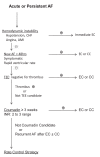Electric cardioversion of atrial fibrillation
- PMID: 20222298
- PMCID: PMC6192814
Electric cardioversion of atrial fibrillation
Abstract
Electrical cardioversion (EC) has been performed for atrial fibrillation (AF) for over 40 years. EC is safe, effective and reliable method for aborting AF especially in unstable situations. Numerous technical and patient characteristics contribute to the success of EC. Recently various developments in this field and newer antiarrhythmic agents have lead to substantial evolution of this procedure. We review the current clinical applications, and techniques.
Figures



Similar articles
-
Cardioversion in atrial fibrillation.Br J Hosp Med. 1993 Feb 17-Mar 2;49(4):256-61. Br J Hosp Med. 1993. PMID: 8443625 Review.
-
Electrical and pharmacologic cardioversion for atrial fibrillation.Cardiol Clin. 2009 Feb;27(1):95-107, ix. doi: 10.1016/j.ccl.2008.09.008. Cardiol Clin. 2009. PMID: 19111767 Review.
-
[Internal cardioversion in chronic atrial fibrillation].Arch Cardiol Mex. 2002 Apr-Jun;72(2):138-44. Arch Cardiol Mex. 2002. PMID: 12148333 Spanish.
-
Contemporary approach to electrical and pharmacological cardioversion of atrial fibrillation.Postgrad Med. 2012 Nov;124(6):26-35. doi: 10.3810/pgm.2012.11.2610. Postgrad Med. 2012. PMID: 23322136 Review.
-
Effect of left atrial size on recurrence of atrial fibrillation after electrical cardioversion: atrial dimension versus volume.Am J Card Imaging. 1996 Oct;10(4):261-5. Am J Card Imaging. 1996. PMID: 9012394
Cited by
-
Cardiac Complications Following Cardiac Surgery Procedures.J Clin Med. 2020 Oct 18;9(10):3347. doi: 10.3390/jcm9103347. J Clin Med. 2020. PMID: 33081028 Free PMC article.
-
Effectiveness of Transesophageal Echocardiography in Preventing Thromboembolic Complications Before Cardioversion: A Narrative Review.Cureus. 2023 Nov 2;15(11):e48149. doi: 10.7759/cureus.48149. eCollection 2023 Nov. Cureus. 2023. PMID: 38046740 Free PMC article. Review.
-
Atrial arrhythmias following lung transplantation: A state of the art review.World J Transplant. 2025 Jun 18;15(2):101005. doi: 10.5500/wjt.v15.i2.101005. World J Transplant. 2025. PMID: 40535489 Free PMC article. Review.
References
-
- Lown B, Perlroth MG, Kaidbey S, Abe T. “Cardioversion” of atrial fibrillation. A report on the treatment of 65 episodes in 50 patients. N Engl J Med. 1963;269:325–331. - PubMed
-
- European Heart Rhythm Association; Heart Rhythm Society. Fuster V, et al. ACC/AHA/ESC 2006 guidelines for the management of patients with atrial fibrillation--executive summary: a report of the American College of Cardiology/American Heart Association Task Force on Practice Guidelines and the European Society of Cardiology Committee for Practice Guidelines (Writing Committee to Revise the 2001 Guidelines for the Management of Patients With Atrial Fibrillation) J Am Coll Cardiol. 2006;48(4):854–906. - PubMed
-
- Dahl CF, Ewy GA, Ewy MD, Thomas ED. Transthoracic impedance to direct current discharge: effect of repeated countershocks. Med Instrum. 1976;10(3):151–154. - PubMed
-
- Kirchhof P, Mönnig G, Wasmer K, et al. A trial of self-adhesive patch electrodes and hand-held paddle electrodes for external cardioversion of atrial fibrillation (MOBIPAPA) Eur Heart J. 2005;26(13):1292–1297. - PubMed
-
- Schneider T, Martens PR, Paschen H, et al. Multicenter, randomized, controlled trial of 150-J biphasic shocks compared with 200- to 360-J monophasic shocks in the resuscitation of out-of-hospital cardiac arrest victims. Optimized Response to Cardiac Arrest (ORCA) Investigators. Circulation. 2000;102(15):1780–1787. - PubMed
Publication types
MeSH terms
LinkOut - more resources
Full Text Sources
Medical
